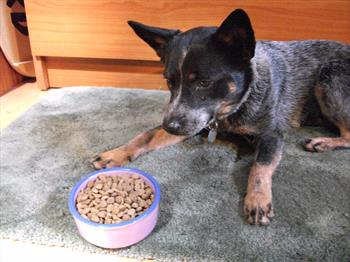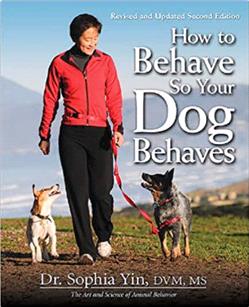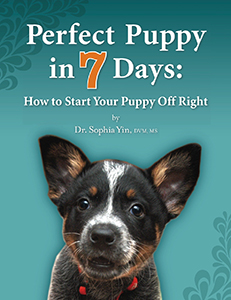What’s up with the dog that eyes people who approach his food bowl or stiffens and even growls, snaps or bites if others interrupt his meal? Don’t they understand that you’re the provider of the things they want and not a threat to them?
Like many dogs that are otherwise easygoing, this type of Fido has a food fetish, and he feels it’s his duty to guard each bowl as if it holds his last meal. While this behavior may seem odd for owners who provide plentiful amounts of food for their pooches, anyone who’s watched free-roaming and stray dogs in developing countries such as Bali or Costa Rica knows that this type of behavior is common. These street or village dogs have to search for their food and never know if they’ll have enough. As a result they may defend food with the vigor of a dog whose life depends on it. This food defense behavior may then just become a habit whether the dog’s hungry or not. Pet dogs can develop the same behavior starting in puppyhood, especially if they experienced strong competition for food.
Often in cases of food bowl aggression, our instinct is to show Fido who’s the boss. For instance some trainers recommend that you force the dog into submission by holding the dog down on its side. After all, they say, that’s what a higher ranked dog would do. What they neglect to point out is that in many cases where a higher ranked dog tries to take food away from a lower ranked one, a fight can and often does occur. The fight may only involve loud growling, spit, and drool, or it may include an actual bite.
Similarly, the problem with humans trying to force dogs into submission in an attempt to show the dog who’s boss is that the boss may turn out to be Fido. If so, the showdown could be ugly, and dangerous as well. Even if it ends quickly and you’re injury-free, the situation may not be resolved. Rather, you may be in for multiple rematches because, now, your dog knows each mealtime means a fight.
What’s even trickier is that sometimes after one all-out battle, everything looks okay on the outside, but, get into Fido’s head, and you might see trouble waiting for your guard to drop. Instead of learning goodwill around the food bowl, Fido has just learned to hide his inner anxiety. He smiles on the outside but he simmers and seethes on the inside when you’re in his feeding space. Then, when he can’t take it anymore, rather than warn you with stiff posture or growls and nips as before, he breaks out in a full-blown bite.
For those who battle this bad behavior with brawn, a third scenario is that, while Fido may decide you are top dog when it comes to the food bowl, all other humans have to fend for themselves. Fido may even behave nicely around the bowl when you’re there to back guests and other family members up, but if you’re out of sight, he may tell them how it is.
So what can you do? Instead of teaching Fido that mealtimes will be a fight and that his fear of having food taken away will come true, train him to associate the presence of people around his food with even better things happening to him.
Method One: For Easy Dogs
At every meal, while Fido’s eating his plain dog food, stand a safe distance away and toss a steady stream (10–30) of bite-sized treats that he loves. Then, when he’s finished and has nothing left to guard, move closer and toss more treats to him or into his bowl. Note that you’ll have to cut back on his regular food so that he gets his normal daily caloric alottment of food. After a few meals using this method, move a bit closer each day, always staying outside Fido’s defensive range. If Fido tenses up or even growls, then you’ve moved too close, too quickly, so watch his body language closely. The key is that he stays relaxed at all times around the bowl and learns to expect even better treats from you. If this method takes you any more than a week, or Fido looks tense, or you’re in any doubt about your ability to safely read Fido’s mood, then you should go to method 2.
Method Two: For More difficult Dogs
A variation on this method is to teach Fido to sit for special treats when he’s eating his meal. Start by teaching Fido to perform say please by automatically sitting during non-meal times. Don’t yell, “Sit, Sit, SIT,” while he’s jumping up to get your attention or a treat; instead, just ignore him by standing as still as a tree. When he happens to sit on his own, quickly deliver the tasty bite-sized treat so that it gets to him within a split second. In fact, since this is only a practice session you can actually use his regular kibble. Next deliver several more sequentially to reward him for remaining seated patiently. Repeat the exercise by briskly walking several steps away as if you’re playing a game and want to get him to follow. Then wait for him to follow you and sit again. Repeat this until he clearly gets the game and thinks it’s fun. Then, randomly practice this throughout the day. If you train him when he’s hungry or motivated for the food reward, he should be an ace at this behavior in just a day or two.
Leave-it, food on the ground: Now apply this automatic “say please by sitting” game to getting other things he wants. We’ll start with the leave-it exercise. This leave-it exercise will teach Fido that he will get what he wants if he just exhibits some self control, so he has no need to be possessive. It also teaches him he gets a lot of things he likes when he’s calmly sitting and looking at you.
Place Fido on leash and hold it at a constant 4–5 foot length. Then toss a treat greater than 4–5 feet away. Fido will run to get it. Don’t say anything. Just hold the leash firmly at the given length as if the leash is tied to a tree. When he gets to the end let him figure out that no matter how hard and long pulls he’s not going to get any closer. Eventually he’ll realize he’s not going to accidentally get rewarded for the rude, uncontrolled pulling behavior and then like magic, he will turn to you and sit. When he does, get a treat to him within 0.5 seconds! Fast!
Continue to give him a string of treats every 2–5 seconds for sitting and looking at you. They should come fast enough so that he just wants to focus on you. Continue until his gaze is stably fixed on you so its clear he’s no longer thinking about running to get the treat on the floor. Then, tell him “Ok!” or use another release word. Then, point and simultaneously walk towards the treat on the floor making sure that you get there fast enough so that he’s on a loose leash. If you’re too slow and he pulls you, then you’ve just negated part of what you trained. If he gets to pull, he won’t learn that leash tension means to stop and look at you. Rather, he’ll learn that pulling just gets him there faster.
For cases where the dog is really possessive about dropped food, especially in cases where you have kids in the house, you may decide that you never want him to pick up dropped food off the ground. In that case you can continue giving him treats for remaining seated and looking at you during this exercise while you walk over to the treat on the floor, pick it up, and give it to him.
Once Fido is good at immediately sitting and looking at you when treats are tossed out of range, you can also teach him the cue word “leave-it” by saying it in a happy voice, as if it’s a game, right as or after you toss the treat out of his range. In training, only use the cue word if you’re sure he’ll sit within a second or two, otherwise it will take a long time for him to learn to associate the word with the actual behavior.
Work on this game a lot so that it becomes a habit within just a day or two.
Go for the full-bore Learn to Earn Program if You Think Fido’s Really Difficult: Note that if you feel your dog is an extremely difficult or dangerous case, you should also put him through the full bore learn to earn program where he actually learns he has to control his impulse to get everything he wants. That is, he has to automatically say please by sitting to earn every single kibble when you’re home with him, to get his leash on, to go out the door, to get petted, during the leave-it game, to have his toy tossed, and for everything he wants. In essence you’re using everything he wants to your advantage to teach him that he can have what he wants but only if he controls himself and looks to you for permission. So it’s not about the human trying to be the boss, it’s about the dog learning that politely asking permission gets him what he wants when it’s ok with you.
The best source for Dr. Yin’s Learn to Earn program.
Specific Food Bowl Training
When he’s good at the above exercises, expect Fido to sit to receive his meals, too. If he’s a particularly difficult or aggressive dog, tether him on leash away from where you will place his bowl so that he can’t lunge and injure you.
Hold his food bowl, which contains his boring kibble, and wait for him to sit. Put the food bowl down outside of his leash range and tell him “leave-it,” just once. If he gets up, that’s okay because he’s on leash and can’t get to the food. Just wait for him to sit. When he’s sitting, give him a few treats and then unhook his leash and give the release word and let him get his meal.
Make sure you’re standing outside his defensive/protective zone (the zone he guards around his food bowl) when you release him so he doesn’t feel threatened. Just let him eat his meal in peace. When he finishes the meal, slowly approach with a mouth-watering morsel and stand right outside his food-bowl protection zone. When he says “please” by sitting, give him a tasty treat. Note that to make this treat special, it has to be one that he only gets during these practice sessions. Peanut butter on a dog biscuit or a piece of real meat are good choices for the early sessions.
Now make this your new daily feeding routine. When Fido regularly sits every time you approach after he’s finished his meal, you can up the ante by approaching during mealtimes-but just to the edge of his feeding space at first so that you don’t cause him to feel defensive. Then give him a treat or two when he sits and then walk away. We want your approach to mean something good to him and your walking away to signal he can resume eating his meal. Again, if he consistently sits immediately upon seeing you approach, you can move closer the next time.
Always wait until he sits to go all the way up to give him his treat. The benefit to this “say please by sitting” technique is that you can better judge what Fido’s thinking. If he sits and looks expectantly to you for treats as you approach, then he sees your approach as something good. Conversely, because you’re only allowed to approach him when he sits and looks expectantly to you for something better than his meal, you’re not likely to mistakenly approach him when he’s feeling he has to protect his bowl.
Speeding up the Progress: To speed your progress, during the first several sessions you can start with one-fourth of your dog’s meal in the bowl so that you can get four practice trials each meal. Once Fido gets the idea that he should sit when you approach you can go back to putting the entire meal in his bowl and then practice approaching him with something better during his meal 1–4 times during his meal.
Later you’ll want to practice having other family members go through the same routine. He should generalize to them almost immediately unless he has some underlying fear of them. The goal of the training is that Fido learns that people approaching him while he’s eating means something good. He’ll get something great and still get to eat his regular food. As a result his underling motivation for being protective will disappear and he’ll be good in general to people approaching him while he’s eating out of his bowl.
Proactively work with puppies and newly adopted dog
Incidentally, as a proactive plan, you can also perform this feeding game with puppies so they don’t become protective of their food. These plans may sound too good to be true, but stick with it, practice patiently, and practice with different people, and Fido’s food bowl fetish will gradually fade away.
To see video of this watch Ben Guards the Food Bowl. This training took the owner a long time at first because they were afraid of Ben and later because we tried several other techniques (for easier dogs) first. Once we started this actual technique described above it just took several weeks.





